The new wave of minimalist and sleek furniture designs has left many collectors pining for the antique ladder back chairs. Once a staple in homes across America, ladder-back chairs are the perfect example of a classic simple aesthetic. Today, many furniture brands are reproducing antique ladder back chairs with a modern twist.
But for those who want the real deal, nothing beats the hand-crafted quality and unique history of an original. If you’re one of those people, this guide is for you. Here, we’ll discuss the history of antique ladder back chairs, how to identify them, and what kind of value they hold today.
Table of Contents
What are Antique Ladder Back Chairs?
Ladder back chairs (also called slat chairs,) are chairs that feature a series of horizontal slats, or “rungs,” across the backrest. These slats are attached to the two horizontal side rails of the chair frame, with groove & tenon joint. Giving a ladder-like appearance, hence the name.
The number and design of the rungs varied by trends over time, but the basic structure of the ladder back chairs remained the same. Overall, ladder-back chairs were designed for comfort and durability. The slats allowed air to circulate, making them ideal for warm summer days. And the simple design made them easy to stack and store away. Though, as we’ll discuss later, some styles did become quite ornate.
Antique ladder back chairs can be with or without arms, have upholstered or rush seats, and be made from different types of wood.
History of Ladder Back Chairs
Ladder back chairs have been around for centuries. There is no telling exactly when or where the first one was made. But we do know that ladder-back chairs were a common household item in 16th-century Europe. The simplicity and functionality made them affordable and practical for the masses.
Early colonists brought the chairs over to America and they gained instant popularity because they suited the needs of the time. People were looking for durable and long-lasting furniture that could be easily moved and stored. They used readily available hardwood and ladder-back chairs began to appear in dining rooms, living areas, and outdoor porches all over America.
By the middle 17th century, American life transitioned to richly ornamented and formal furniture. So, the ladder-back chairs took on a more refined look with turned spindles, carved scrolls, and other decorations. Manu luxury furniture makers began adding their own spin to the ladder back chairs.
One exception was the Shaker community, a religious sect that believed in simple living. Shakers created their own versions of the ladder back chair, emphasizing durability, function, and a clean unadorned look. Most antique ladder back chairs available today come from this period of American history.
As the Victorian era approached, the interest in opulent over the top designs increased. The ladder-back chairs got demoted from the dining room to the kitchen and lost their popularity for a time. Now, 21st-century Americans are returning to the ladder-back chairs for their rustic charm and simple elegance. So they’re making a comeback with a vengeance!
Types of Ladder Back Chairs
Ladder back is just the general term for chairs that feature horizontal slats across the backrest. But depending on the other features, the chairs can fall into different subcategories. Here are some of the most recognized types of ladder-back chairs;
Shaker Style
These are the most iconic and popular types of ladder-back chairs. Shaker style is a reflection of the Shaker community’s belief in simplicity. They made light but sturdy ladder-back chairs out of oak, mahogany, and maple. The overall building was clean with straight lines and no unnecessary adornments, with every single part intended to serve a purpose.
The seats were usually made of woven cotton tapes; more comfortable than rush. Early versions of the chairs were made without arms but by the late 1800s, plenty of armchair versions were in circulation. Shakers also introduced the ’tilter’ chair. These chairs have slightly shorter back legs so the chair naturally stays comfortable at a laid-back angle. The rocking ladder back chair is also a variation of the Shaker style.
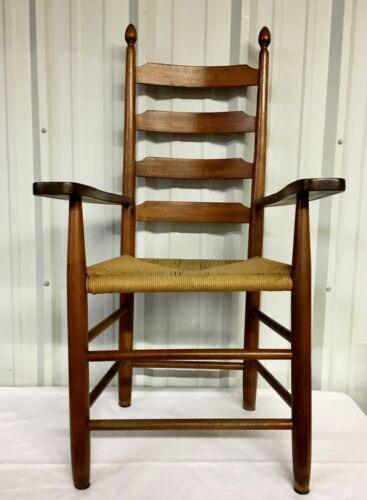
French Provincial
Instead of straight lines, French chairs feature gentle curves, scalloped edges, and sometimes turned legs. These chairs are often bigger and more substantial than the Shaker type. The backrest slats are also typically wider, with floral motifs carved on the top slat.
Seats are usually rush or cane but some of the later versions feature upholstered seats for extra comfort. You’ll also find more variation in the wood type used for French ladder-back chairs. Oak is still the most popular choice but you’ll also see cherry, walnut, and beech.
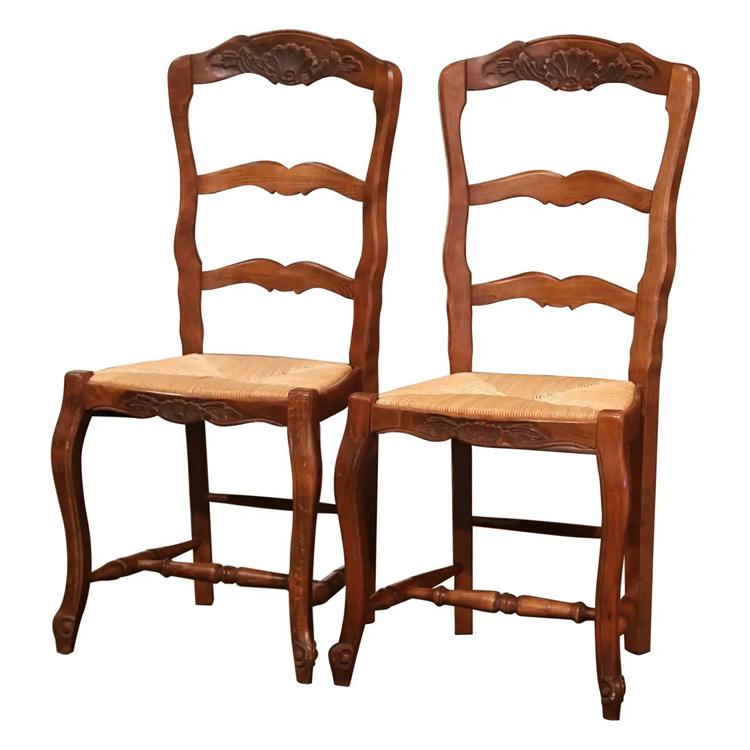
Victorian Style
As the furniture style turned more opulent in the Victorian era, simple ladder back chair lost their charm. So the new trend was to add more decoration and embellishments. That’s why you’ll see a lot of variation in Victorian ladder-back chairs.
Decorative features like turned legs, pierced back slats, heavily carved details, often in a floral or grapevine motif, and upholstered seats became popular. Chair aprons also became more ornate, featuring intricate carvings and inlays. In addition to the more common woods like oak and cherry, mahogany became a popular choice for Victorian ladder-back chairs.
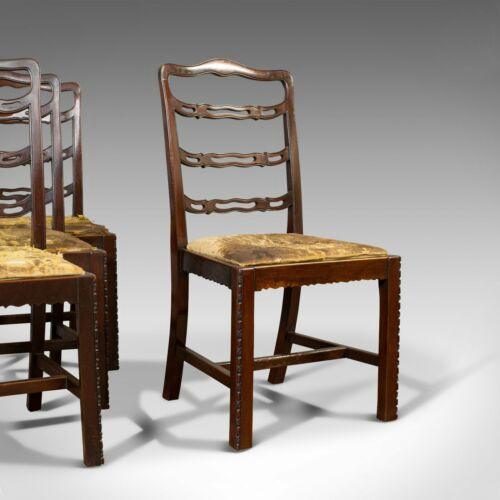
Rocking Ladder Back Chair
Rocking ladder back chairs were there from the beginning but they became more popular in the Victorian era. As the name suggests, these chairs have a rocking mechanism that allows for a gentle back-and-forth motion.
As shakers made the first versions, the early rocking chairs were humble and unadorned. But as the style evolved, they started to feature more elaborate designs. And they were quite popular in the Victorian era.
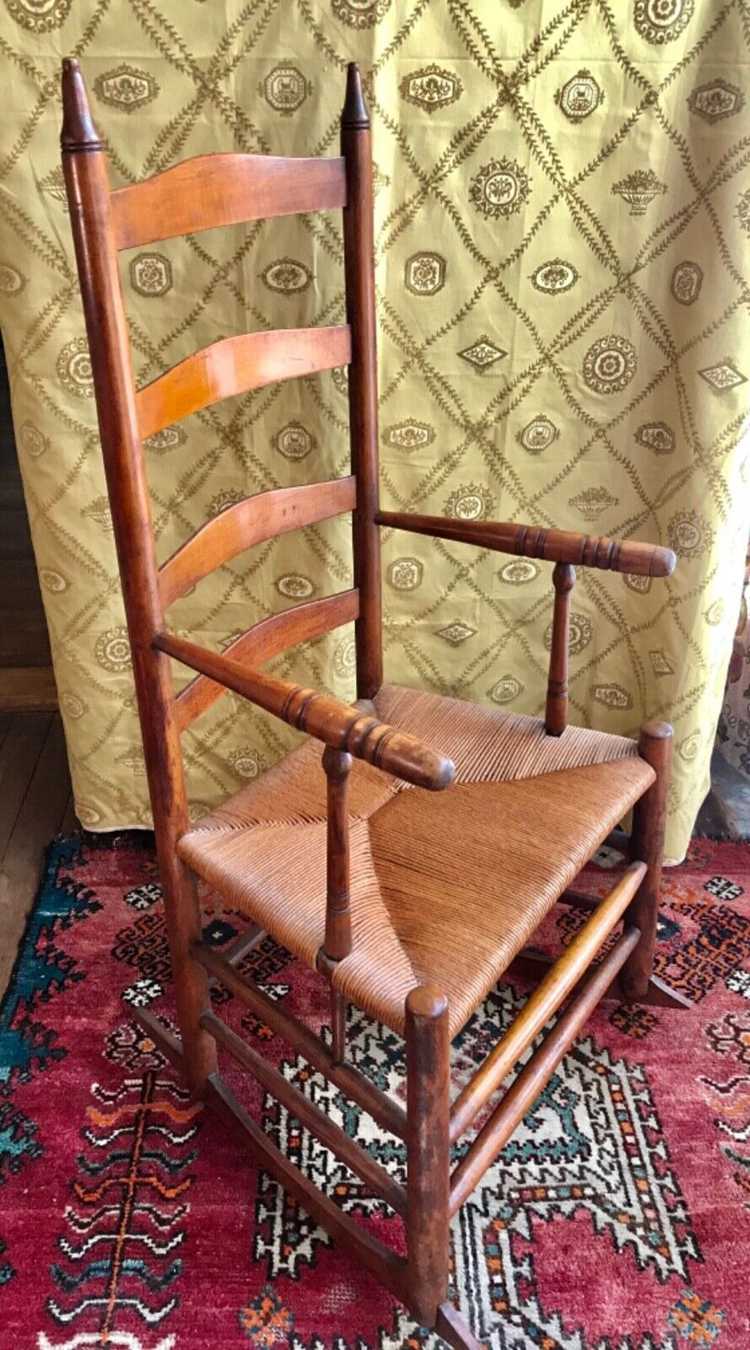
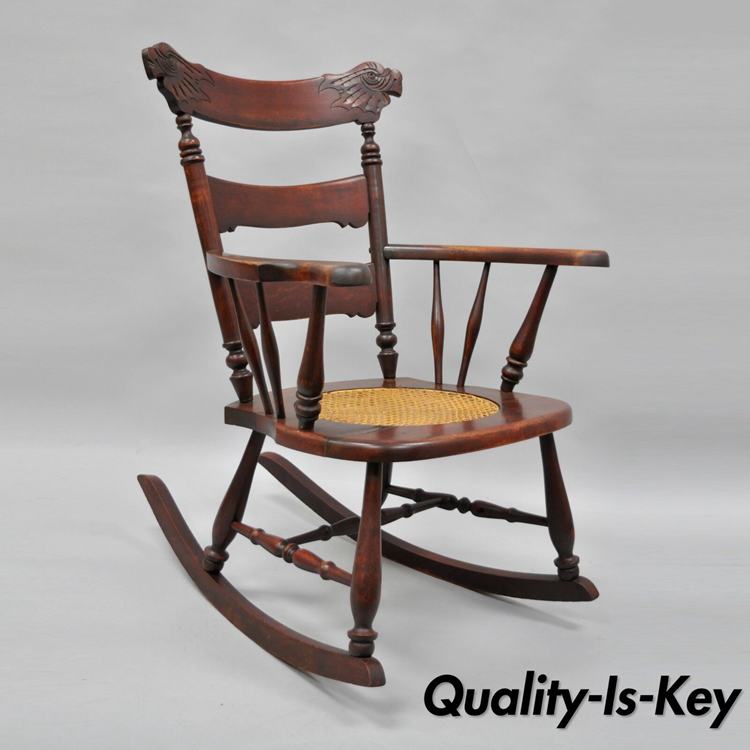
Children’s Ladder Back Chair
When shopping for antique ladder back chairs, you’ll frequently come across children’s chairs. Because of the simplicity and sturdiness of the design, many families got ladder-back chairs for their kids. Which survived through the generations and now we see them in antique shops.
Kids’ ladder-back chairs remained simple and unadorned like the original Shaker-style chairs. But you can find variations in the seating, materials, and colors.
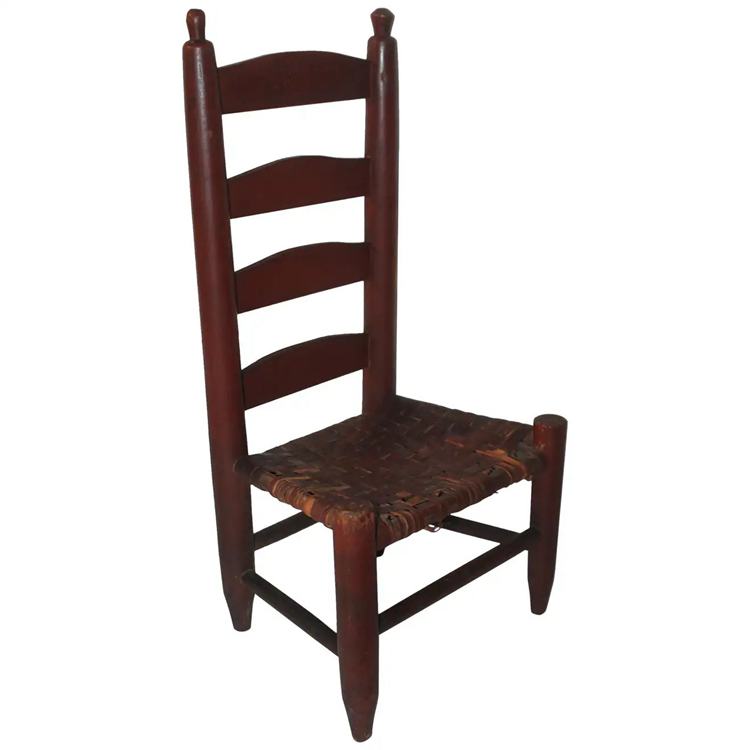
How to Identify an Antique Ladder Back Chair?
Now that you know the different styles of antique ladder back chairs, let’s look at how you can identify them.
Joints and Joinery Details
Antique chairs are centuries old when the joinery methods were limited. So the way the different parts of the chair are put together can help you identify its age and style.
For example, in the 18th-century mortise and tenon joint was the most popular way to assemble a chair. Dowel joints began to be used in the early 19th century. And machine-cut dovetails were not common before the 1880s. So if you see a ladder back chair with any of these joinery details, it’s likely from the appropriate time period.
The finish and symmetry of these joints also matter. A handmade chair from the 18th century wouldn’t have equally spaced and perfectly flush joints like we see today. Uneven spacing and slight misalignment are good indicators of an antique chair.
Stylistic details
As we discussed earlier, ladder-back chairs went through many design changes over the centuries. So those clues can help you date and identify a chair.
For example, early American ladder back chairs often have a plain H-stretcher to give extra support to the seat. You’ll also see this stretcher in some early Victorian chairs. But it became less common as the chairs got more decorative and intricate.
Another example is carved aprons, you’ll almost never find them on early ladder back chairs. But they became increasingly common in the Victorian era. The same goes for the carving patterns.
Age and Wear
Of course, the overall condition of the chair is another important indicator of its age. A few nicks and scratches, wood stretching, and patina are all signs of age and wear. But be aware that these can also be faked. So make sure the ware signs are consistent across the chair.
Manufacturing Marks or Labels
Most ladder-back chairs from the 18th and 19th centuries come from local craftsmen or family-run shops. So they rarely have any sort of label or manufacturing marks. However, a few furniture firms also tried their hand at making luxury ladder back chairs in the 19th century. So you might find a manufacturer’s label or stamp on those chairs.
Antique Ladder Back Chairs Value Guide
Antique ladder back chairs can be worth anywhere from a few hundred to a few thousand dollars. The value depends on several factors including;
Proper Restoration
Chairs are a common household item that is used frequently. So it’s not surprising that many antique ladder back chairs have been restored at some point. Which is considered appropriate as long as it’s done properly.
However, from the value standpoint, restoration work should only focus on the preservation of original features. So, for example, if the chair needs a new coat of paint; use the original paint color. And if the seat is worn out, replace it with period-appropriate fabric or weaving. Be deliberate with your choices and don’t make any changes that can’t be undone.
Uniqueness and Rarity
Like with any other antique, the more unique and rare a ladder back chair is, the more it’s worth. This includes the chairs from the early colonial era or the ones with unique features that are hard to find. Ladder back chairs from famous designers or master craftsmen are also rare and valuable.
One great example is this Renaissance-style green and gold painted & carved ladder back chair from the 17th century. The beautiful piece has every element to make it worth $3500:
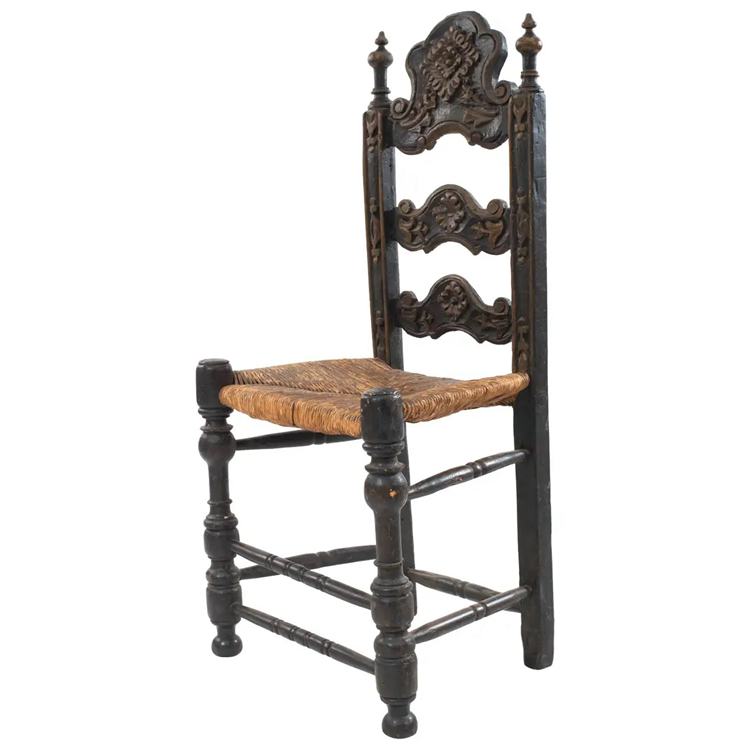
Rennie Mackintosh’s famous Hill House ladder back chair 1 design is patented by Italian company Cassia, it’s still reproduced in limited numbers. But antique pieces from the early 19th century are very rare and sell for thousands of dollars.
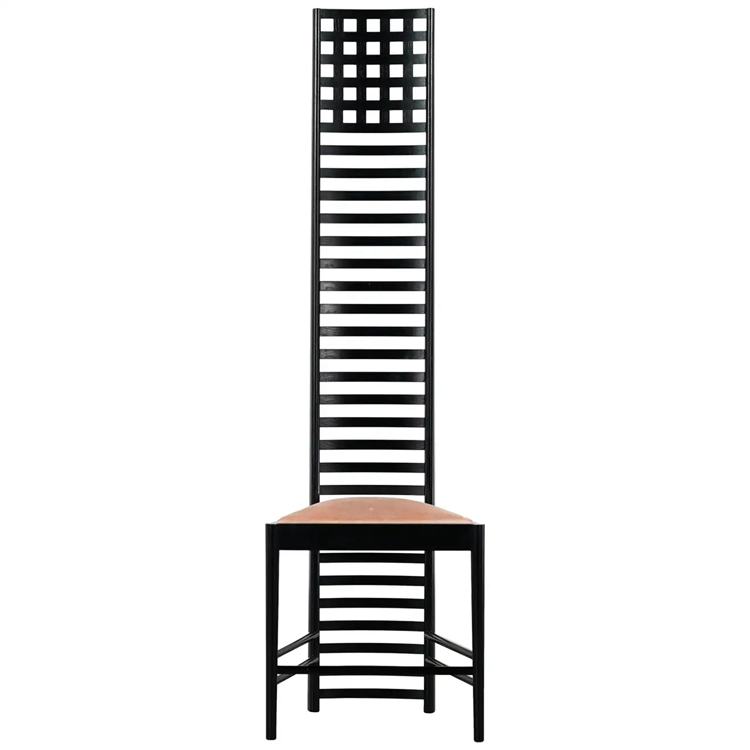
Quality of Craftsmanship
Quality includes both the materials used and the level of craftsmanship. Obviously, better quality materials like mahogany or cherry wood are more valuable. But even the more common woods like oak can be valuable if they’re used in a high-quality piece.
And if the chair is carved or has complex design elements, it will also add to the value. Especially if it’s done by a skilled craftsman.
This tiger maple, Queen Anne style rocking chair from the late 18th century and lightweight built and perfect finish is an excellent example of great quality. It’s listed for $1875:
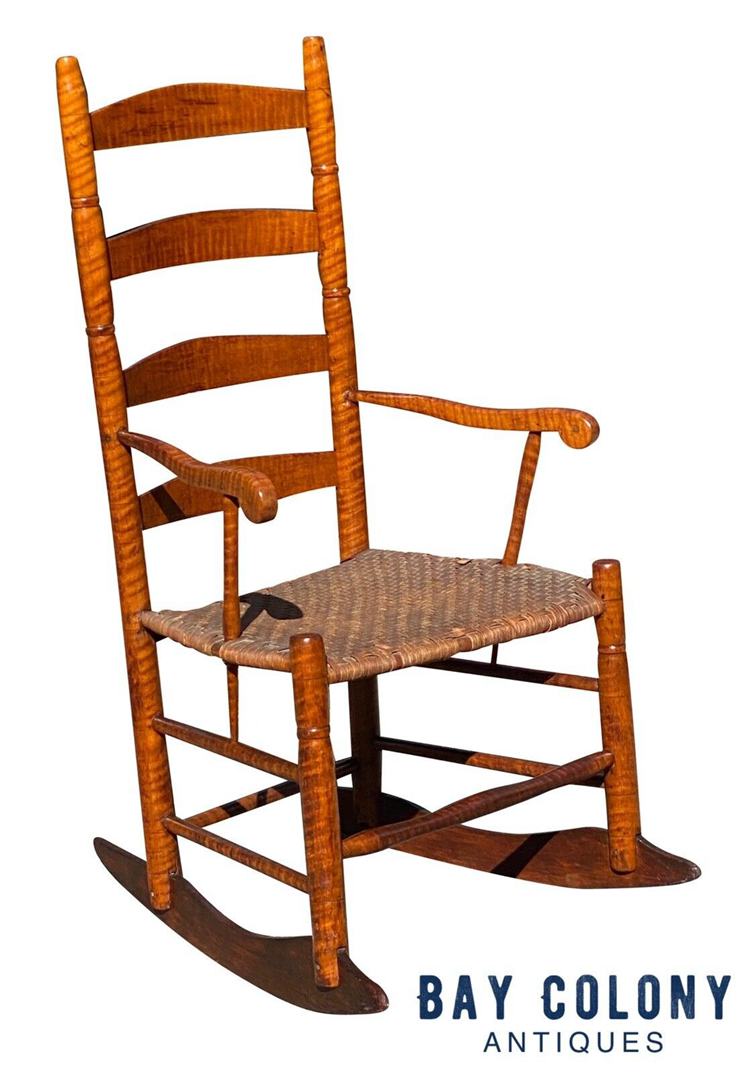
Availability in Sets
People often look for chairs in pairs or sets, especially if they’re buying for a dining room. So, ladder back chairs set can fetch a higher price.
This set of 4 Victorian mahogany ladder back chairs from 1880 is listed for $2195:
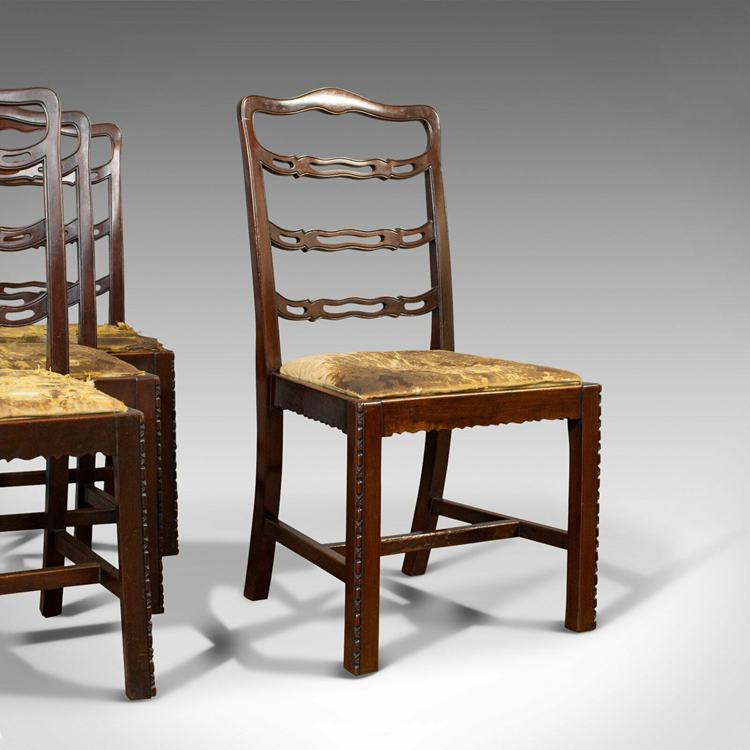
Buying and Selling Antique Ladder Back Chairs
The biggest issue with buying or selling antique chairs is that they’re mostly restored. And without a close inspection, it’s hard to tell how well the restoration work was done. So, buying or selling without credible expertise is risky and not recommended.
If you’ve got a keen eye for detail and know your way around antique furniture, you can find some great deals at garage sales, flea markets, or antique stores. But if you’re not confident in your abilities, it’s best to consult with an expert or buy from a reputable dealer.
When you’re buying, make sure to inspect the piece carefully. Check for signs of damage or repair work and ask questions about the history of the chair. If possible, get a written guarantee of authenticity and have the piece appraised before you finalize the purchase. When selling, it’s important, to be honest about the condition of the piece and any repairs or restoration work that’s been done.
Other than personal sales, online auction sites like eBay or live auction houses are great places to buy or sell antique ladder back chairs.
Restoring Antique Ladder Back Chairs
Antique chairs often need some level of restoration, and a good restoration can increase the value of the piece. But it’s important to make sure that any work is done by a qualified professional. Different types of wood finishes and construction methods require different restoration techniques. And if the work isn’t done properly, it can damage the piece.
If you’re considering restoring a ladder back antique chair yourself, do some research and make sure you understand the process. It’s a good idea to consult with a professional before you start any work.
Here we’ve found a great video tutorial on how to refinish an antique chair. But this is just beginner-level work and the chairs only need light sanding and staining. For more complex projects, it’s best to consult with a professional:
Let’s do a quick step-by-step recap of what was done in the video:
Step #1: Cleaning
Wipe down the chair with a damp cloth to remove any dirt or dust. You can use a mild detergent if the chair is very dirty.
Step #2: Sanding
You’ll need to do multiple sanding sessions. Start with a coarse grit (220) sandpaper and sand down any rough spots and major imperfections. Then move to a finer grit (120) sandpaper and sand the entire chair.
If your chairs have peeling paint or varnish, you may need to use other methods to strip it.
Step #3: Applying Oil
If you want a natural wood finish, a few coats of mineral oil can really bring out the beauty of the wood grain. Linseed oil, tung oil, and teak oil are also good options. Just soak a clean cloth in the oil and rub it into the wood. Apply multiple coats and let each coat soak in for at least 5-6 hours before adding the next. Alternate between wiping on the oil and buffing it off until you achieve the desired finish.
Step #4: Staining (optional)
If you want to change the color of your chairs, now is the time to do it. Wood stains come in a wide range of colors, so you can really get creative here. Just make sure to follow the directions on the can and test the stain on a hidden area of the chair before you commit to it.
Once you’re happy with the color of your chairs, apply a clear finish to protect the wood and provide a long-lasting shine.
Step #5 Restoring Seat
Again, the method depends on the type of seat your chairs have.
- Upholstered: Clean with a mild detergent or get new upholstery.
- Rush: Apply a coat of shellac or re-weave the seat.
- Cane: Clean with a mild detergent or re-weave with new ratten.
- Leather: Treat with a leather conditioner
Conclusion
Antique ladder back chairs are beautiful pieces of furniture that can add both style and value to your home. But, like with any antique, there are some things you need to know before you buy or sell. Here’re the takeaways :
- Antique ladder-back chairs come in different styles, Shaker style chairs are the most popular and common.
- The value of an antique ladder back chair depends on several factors including, proper restoration, uniqueness & rarity, quality of craftsmanship, and availability in sets.
- Antique ladder back chairs are often restored, so it’s important to inspect them carefully before you buy.
- The best places to buy or sell antique ladder back chairs are barn sales, antique stores, online auction sites, or live auction houses.
- Ladder back chairs are restored according to their material makeup. To do it yourself, you’ll need to know how to sand and apply oil or stain. If the project is more complex, it’s best to consult with a professional.
FAQs
What is the average price for an antique ladder back chair?
The value of an antique ladder back chair depends on several factors including, proper restoration, uniqueness & rarity. On average, a well-restored common Shaker-style ladder back chair can sell for around $200.
What is the difference between ladder back chairs and widsor chairs?
Ladder back chairs have horizontal slats between the chair back posts, while Windsor chairs have vertical slats or spindles. Windsor chairs also have a distinctive wide, saddle shape back while ladder back chairs typically have a more narrow, straight look.
What era are antique ladder back chairs from?
The first ladder-back chairs were made in the Middle ages (5th-15th century). However, the vast majority of antique ladder back chairs available today were produced in the 18th and 19th centuries.
How can I tell if my ladder back chair is an antique?
If you can determine the origin of your ladder back chair or trace it back to at least the early 1900s, then it is likely an antique. To be certain, take it to an appraiser or antique dealer for a professional opinion.
What is the difference between an antique and a vintage ladder back chair?
An antique is defined as an item that is at least 100 years old, while a vintage item is at least 40 years old. Therefore, all antique ladder back chairs are considered vintage, but not all vintage ladder back chairs are antique.





![Where To Sell Antique Furniture In 2022 [Ultimate Guide]](https://www.jacquelinestallone.com/wp-content/uploads/2022/09/Etsy-Your-Place-To-Buy-And-Sell-All-Things-Handmade-600x450.jpg)


